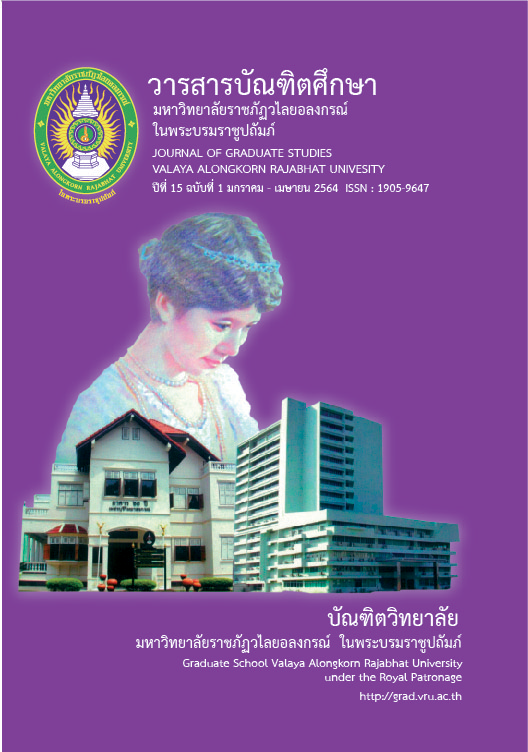THE DEVELOPMENT OF RELATIONSHIP MODEL OF HUMAN RESOURCES PROFESSION ROLES AND COMPETENCIES AFFECTING ORGANIZATION EFFECTIVENESS
Main Article Content
Abstract
The purpose of this research is to investigate causal relationship among Human Resource Profession Role (HRR), Human Resource Profession Competencies (HRC), and Organization Effectiveness (ORE). Sampling data were collected from 3 Telecommunication Business, including 290 HR practitioners. Confirmatory Factor Analysis (CFA) and Structure Equation Modeling (SEM) are the chosen methods for statistical data analysis.
Findings reveal that: HRR’s elements are Strategic Partner, Administrative Expert, Employee Champion, Change Agent, Human Capital Developer and HR Leader; HRC’s elements are Strategic Positioner, Credible Activist, Capability Builder, Change Champion, HR innovator and Integrator and Technology Proponent, ORE’s elements are Human Relations, Open System, Rational Goal, Internal Process. As per the causal relationship between HRR, HRC and ORE, it is found that HRR’s elements and HRC’s elements have both direct effect to ORE.
Article Details
บทความทุกเรื่องได้รับการตรวจความถูกต้องทางวิชาการโดยผู้ทรงคุณวุฒิ ทรรศนะและข้อคิดเห็นในบทความวารสารบัณฑิตศึกษา มหาวิทยาลัยราชภัฏวไลยอลงกรณ์ ในพระบรมราชูปถัมภ์ มิใช่เป็นทรรศนะและความคิดของผู้จัดทำจึงมิใช่ความรับผิดชอบของบัณฑิตวิทยาลัย มหาวิทยาลัยราชภัฏวไลยอลงกรณ์ ในพระบรมราชูปถัมภ์ กองบรรณาธิการไม่สงวนสิทธิ์การคัดลอก แต่ให้อ้างอิงแหล่งที่มา
References
Anutragulchai, S., Siwarom, M. and Ladawan, T. (2016). khwāmsamphan khrōngsāng chœ̄ng sāhēt khō̜ng samatthana nakbō̜rihān sapphayākō̜n manut thī song phon tō̜ prasitthiphon khō̜ng samnak khāi læ bō̜rikān lūkkhā phūmiphāk thī sō̜ng bō̜risat thī ʻō thī čhamkat (Mahāchon) [The casual model of structural relationship among competencies of human resource managers affecting the effectiveness of Regional Sales and Customer Services 2, TOT Public Company]. Journal of Graduate Studies Valaya Alongkron Rajabhat University, 11(3), 208-220.
Chatmathasit, C. (2014). kān wikhro̜ chœ̄ng prīapthīap khwāmkhātwang nai botbāt khō̜ng nakbō̜rihān sapphayākō̜n manut nai thāna phanthamit thurakit khō̜ng phūbō̜rihān radap ton nai hā thurakit nai bō̜risat thrū khō̜pō̜rēchan čhamkat (Mahāchon) [The comparative analysis of the expectation of human resource’s roles as business partner of line manager in True corporation public company limited]. Panyapiwat Journal, 5(2), 49-61.
Conner, J., and Ulrich, D. (1996). Human resource roles: creating value, not rhetoric. Human Resource Planning, 19(3), 38 - 47.
Du Plessis, A. J., Paine, M. S., and Botha, C. J. (2012). The role of human resource practitioners maintaining sustainability in organisations: Some empirical evidence of expectations, challenges and trends. International Journal of Contemporary Business Studies, 3(4), 16-34.
Edvinsson, L., and Malone, M. S. (1997). Intellectual capital: Realizing your company’s true value by finding it hidden brainpower. New York: Haper- Collins.
Han, J., Chou, P., Chao, M., and Wright, P. M. (2006). The HR competencies‐HR effectiveness link: A study in Taiwanese high‐tech companies. Human Resource Management, 45(3), 391-406.
Prikshat, V.,and Kumar, S. (2014). The Roles, Competencies and skills of HRM professionals in Indian organisations. Proceedings of the International Conference on Human Resource Management and Organization Effectiveness In Asia Pacific (Kota Kinabalu, Malaysia – December 4-5, 2014) Paper No.1436. 1-10.
Punnitamai, W. (2010). botbāt samatthana læ khwāmpen mư̄ʻāchīp khō̜ng nak sapphayākō̜n manut Thai : wikrit ngīap thāmklāng khwām dư̄ran nai thamnīam patibat [Roles, competencies, and professionalism of Thai HR practitioners:Silent crises amid stubborn traditionalism]. NIDA Development Journal, 50(3). 43-74.
Punnitamai, W. (2013). kānsưksā khwāmsamphan chœ̄ng sāhēt khō̜ng samatthana læ botbāt khō̜ng nak sapphayākō̜n manut Thai thī mī tō̜ kān sō̜ ngom ʻop khunkhā dān kānbō̜rihān sapphayākō̜n manut kǣ ʻongkān [An Investigation of the causal relationship between HR competencies and roles on delivering values to an organization: A case of Thai HR practitioners]. NIDA Development Journal, 53(3), 105-123.
Puwittayathorn, T. (2016). botbāt nak sapphayākō̜n manut thī song phon tō̜ prasitthiphonʻongkān dān phanakngān khō̜ng wisāhakit khanāt klāng [The roles of HR affecting employees effectiveness of mid-sized enterprise]. Panyapiwat Journal, 8(2), 90-99.
Puwittayathorn, T. (2018). samatthana nak sapphayākō̜n manut nai ʻamphœ̄ ko̜ samui čhangwat surātthānī [Human resource competency in Koh sSamui, Surat Thani Province]. Journal of Southern Technology, 11(1), 145-156.
Quinn, R. E., & Rohrbaugh, J. (1983). A Spatial Model of Effectiveness Criteria : Towards a competing values approach to organizational analysis. Management Science. 29(3), pp. 363-377.
Rangsungnoen, K. (2011). kān wikhro̜ patčhai dūai SPSS AMOS phư̄a kānwičhai. Bangkok: SE-Education
Sincharu, T. (2014). Kānwičhai læ wikhro̜ khō̜mūn thāng sathiti dūai SPSS læ AMOS. (3th ed.). Bangkok: Business R&D.
Society for Human Resource Management. (2012). SHRM Competency Model. Retrieved from http://www.shrm.org/hrcompetencies/pages/default.aspx
Suchatprasoetkun, A. (2010). botbāt khō̜ng nak sapphayākō̜n manut læ phonkān patibat ngān khō̜ng ʻongkān. Human resource roles and organizational performance. Master of Business Administration Thesis (Thammasat Business School). Thammasat University.
Ulrich, D. (1997). Human resource champions: the next agenda for adding value and delivering result. Boston: Harvard business school press.
Ulrich, D., and Brockbank, W. (2005). The HR value proposition. Boston: Harvard business school press.
Ulrich, D., Younger, J., Brockbank, W., & Ulrich, M. (2013). The state of the HR profession. Human Resource Management. 52(3), 457-471.


